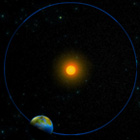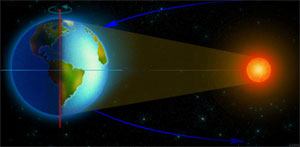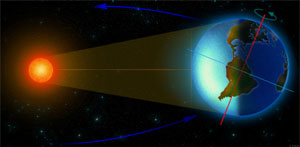Sun and Earth and Temperature Change
 Image courtesy of NOAA. Astronomer Milutin Milankovitch |
What causes the Earth’s climate to change?
Climate change is complex—there are many dynamics involved. A major factor may be the relationship between the Earth and the Sun.
Astronomer Milutin Milankovitch (1879 – 1958) studied the variations in the shape of the Earth’s orbit around the Sun and the tilt of the Earth’s axis. He theorized that these cyclical changes and the interactions among them were responsible for long-term climate changes.
Milankovitch studied three factors:
-
Changes in the tilt of the Earth’s axis;
-
Variations in the shape of the Earth’s orbit around the Sun; and
-
Precession: changes in how the tilt of the axis is oriented in relation to the orbit.
The Earth’s Tilt
If the Earth did not tilt, there would be no seasons and day and night would be the same length all year. The amount of solar energy reaching any given location on Earth would be constant throughout the year. But the Earth is inclined at an angle of 23.5°. When it is summer in the Northern Hemisphere, beginning in June, northern latitudes receive more sunlight than the Southern Hemisphere. Days are longer and the angle of the Sun is higher. Meanwhile, in the Southern Hemisphere it is winter. Days are shorter and the angle of the Sun is lower.
|
Click for larger image. The Earth’s axis is not perpendicular to the plane of its orbit. It is inclined at an angle of 23.5°. This causes the Northern Hemisphere to receive the most direct Sun and have the most, hours of daylight in June, with less direct Sun and fewer daylight hours in December. This accounts for the seasons. In the Southern Hemisphere, the seasons are reversed. |
|
|
Click to change the tilt of the Earth's axis. Variation in axial obliquity. |
Click to change the orbit and see what happens. Variation in the Earth's orbit. |
|
Click for larger image. The Earth without seasons; Earth's axis at 0°. |
|
|
Click for larger image. Late June: Northern Hemisphere summer, Southern Hemisphere winter. |
|
|
Click for larger image. Late December: Northern Hemisphere winter, Southern Hemisphere summer. |
|
Half a year later, the Earth has moved to the other side of its orbit around the Sun. It remains tilted in the same direction. So now it is summer in the Southern Hemisphere, with longer days and more direct sunlight. It is winter in the Northern Hemisphere.
Milankovitch theorized that the inclination of the Earth’s axis is not always 23.5°. There is a bit of wobble over time. He calculated that the tilt changes between 22.1° and 24.5° within a cycle of about 41,000 years. When the tilt is less, summers are cooler and winters milder. When the tilt is greater, the seasons are more extreme.
How does this affect overall climate? Even though winters may be milder, they will still be cold enough for it to snow in areas far from the equator. And if summers are cooler, then it is possible that the winter snows in those high latitudes will not melt so easily. Snow will build up from year to year, forming glaciers.
Compared with water and land, snow reflects more of the Sun's energy into space, causing additional cooling. At this point, a positive feedback mechanism comes into play. The drop in temperature causes additional accumulation of snow and growth of glaciers. This further increases reflection, so temperature is reduced further, and so on. This may be how ice ages begin.
The Shape of the Earth’s Orbit around the Sun
The second factor studied by Milankovitch is the shape of the Earth's orbit around the Sun. It is not quite circular. The Earth is a bit closer to the Sun at some times of the year than at others. Slightly more solar energy is received when the Sun and Earth are closest (the perihelion) than when they are farthest apart (the aphelion).
But the shape of the Earth’s orbit is also changing on cycles of between 90,000 and 100,000 years. There are times when it is more elliptical than it is now, so the difference in solar radiation received at the perihelion and aphelion will be greater.
The perihelion currently occurs in January and the aphelion in July. This serves to make the Northern Hemisphere seasons a bit less extreme since the extra warming effect is in the winter. In the Southern Hemisphere the seasons are a bit more extreme than they would be if the Earth’s orbit around the Sun were circular.
Precession
But there is another complication. The orientation of the tilt of the Earth’s axis changes over time. Like a spinning top that is winding down, the axis moves in a circle. This movement is called precession. It occurs on a 22,000-year cycle. This causes the seasons to slowly shift through the year. Some 11,000 years ago the Northern Hemisphere was tilted toward the Sun in December rather than in June. Winter and summer were reversed. They will have switched again 11,000 years from now.
These three factors—tilt, orbital shape, and precession—combine to create changes in climate. Since these dynamics are operating on different time scales, their interactions are complicated. Sometimes their effects reinforce each other and sometimes they tend to cancel each other. For example, 11,000 years from now when precession has caused the Northern Hemisphere summer to begin in December, the effect of an increase in solar radiation at the perihelion in January and decrease at the aphelion in July will exaggerate Northern Hemisphere seasonal differences rather than soften them as is the case today. But it’s not that simple either, because the dates of the perihelion and aphelion are also shifting.
Other Factors Affecting Climate
Aside from these effects of the movement of the Earth, are there other causes of climate change? Read on…
This content has been re-published with permission from SEED. Copyright © 2025 Schlumberger Excellence in Education Development (SEED), Inc.







